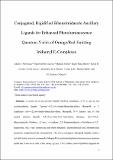Conjugated, rigidified bibenzimidazole ancillary ligands for enhanced photoluminescence quantum yields of orange/red-emitting iridium(III) complexes
Abstract
A series of six novel [Ir(C^N)2(N^N)](PF6) complexes (C^N is one of two cyclometalating ligands: 2-phenyl-4-(2,4,6-trimethylphenyl)pyridine, MesppyH, or 2- (napthalen-1-yl)-4-(2,4,6-trimethylphenyl)pyridine, MesnpyH; N^N denotes one of four neutral diamine ligands: 4,4’-di-tert-butyl-2,2’-bipyridine, dtbubpy, 1H,1’H-2,2’- bibenzimiazole, H2bibenz, 1,1’-(α,α’-o-xylylene)-2,2’-bibenzimidazole, o-Xylbibenz or 2,2’- biquinoline, biq) were synthesised and their structural, electrochemical and photophysical properties comprehensively characterised. The more conjugated MesnpyH ligands confer a red-shift in the emission compared to MesppyH but maintain high photoluminescence quantum yields due to the steric bulk of the mesityl groups. The H2bibenz and o-Xylbibenz ligands are shown to be electronically indistinct to dtbubpy but give complexes with higher quantum yields than analogous complexes bearing dtbubpy. In particular, the rigidity of the o-Xylbibenz ligand, combined with the steric bulk of the MesnpyH C^N ligands, give a red-emitting complex 4 (λPL = 586, 623 nm) with a very high photoluminescence quantum yield (ΦPL = 44%) for an emitter in that regime of the visible spectrum. These results suggest that employing these ligands is a viable strategy for designing more efficient orange-red emitters for use in a variety of photophysical applications.
Citation
Henwood , A F , Antón-García , D , Morin , M , Rota Martir , D , Cordes , D B , Casey , C , Slawin , A M Z , Lebl , T , Buehl , M & Zysman-Colman , E 2019 , ' Conjugated, rigidified bibenzimidazole ancillary ligands for enhanced photoluminescence quantum yields of orange/red-emitting iridium(III) complexes ' , Dalton Transactions , vol. 48 , no. 26 . https://doi.org/10.1039/C9DT00423H
Publication
Dalton Transactions
Status
Peer reviewed
ISSN
1477-9226Type
Journal article
Description
EZ-C acknowledges the University of St Andrews for financial support. We thank Umicore AG for the gift of materials. We would like to thank the Engineering and Physical Sciences Research Council for financial support for E.Z-C. (EP/M02105X/1) and for the studentship of A.H. (EP/J500549/1, EP/K503162/1, EP/L505097/1). We thank the EPSRC UK National Mass Spectrometry Facility at Swansea University for analytical services. We also would like to thank EaStCHEM and the School of Chemistry for supporting the computing facilities maintained by Dr. H. Früchtl.Collections
Items in the St Andrews Research Repository are protected by copyright, with all rights reserved, unless otherwise indicated.

